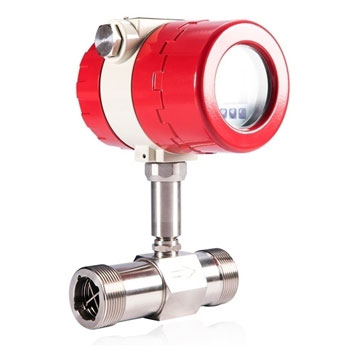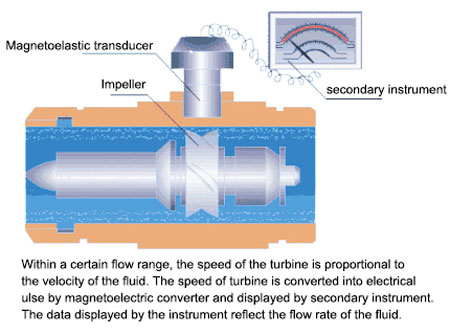The liquid turbine flow meter is a precision flow measuring instrument, which can be used to measure the flow and total amount of liquid when matched with the corresponding flow totalizing instrument. Liquid turbine flow meters are widely used in measurement and control systems in petroleum, chemical, metallurgy, scientific research, and other fields. Liquid turbine meters equipped with sanitary fittings can be used in the pharmaceutical industry.
The structure of the integrated liquid turbine flow meter is an explosion-proof design, which can display the total flow, instantaneous flow, and percentage of full flow. The battery adopts a long-term lithium battery, and the service life of the battery of the single-function integrating meter can reach more than 5 years, and the service life of the battery of the multi-function display meter can also reach more than 12 months. The integrated meter can display many flow units, including cubic meters, gallons, liters, standard cubic meters, standard liters, etc., and can set fixed pressure and temperature parameters to compensate for the gas. For occasions where the pressure and temperature parameters do not change much, the meter can be used for fixed compensation integration.

Liquid turbine flow meter characteristics
- High precision, generally up to ±1%R, ±0.5%R, high-precision type up to ±0.2%R.
- Good repeatabilities, such as frequent calibration or online calibration can get extremely high accuracy, it is the preferred flow meter in trade settlement.
- The liquid turbine flow has a three-point correction of the instrument coefficient, which intelligently compensates for the non-linearity of the instrument
coefficient, and can be corrected on-site. - All valid data will not be lost for 10 years after power failure.
- The range is wide, the medium and large diameters can reach 1:20, and the small diameter can reach 1:10.
- Compact and lightweight structure, easy installation and maintenance, large flow capacity.
- The liquid turbine flow meter is suitable for high-pressure measurement, and there is no need to open holes in the meter body, so it is easy to make a high-pressure meter.
- There are many types of special-purpose sensors, which can be designed into various special-purpose sensors according to the special needs of users, such as low-temperature type, two-way type, downhole type, sand mixing type, etc.
- The liquid turbine flow can be made into an insertion type, suitable for large-caliber measurement, with small pressure loss, a low price can be taken out
without continuous flow, and easy to install and maintain.
How does a liquid turbine flow meter work?
A turbine is placed in the center of the pipe, supported by bearings at both ends. When the fluid passes through the pipeline, it impacts the blades of the turbine flow meter, generating a driving torque to the turbine flow meter, which makes the turbine flow meter rotate by overcoming the frictional moment and fluid resistance moment. In a certain flow range, for a certain fluid medium viscosity, the rotational angular velocity of the liquid turbine flow meter is proportional to the fluid flow velocity. Thus, the fluid flow rate can be obtained through the rotational angular velocity of the turbine flow meter, so that the fluid flow through the pipeline can be calculated.

The rotational speed of the turbine flow meter is detected by the sensing coil installed outside the casing. When the turbine flow meter vane cuts the flux lines generated by the permanent magnet in the housing, it causes a change in the magnetic flux in the sensing coil. The sensing coil sends the detected magnetic flux periodic change signal to the preamplifier, amplifies and shapes the signal, generates a pulse signal proportional to the flow velocity, and sends it to the unit conversion and flow integration circuit to obtain and display the cumulative flow value; At the same time, the pulse signal is also sent to the frequency current conversion circuit, which converts the pulse signal into an analog current, and then indicates the instantaneous flow value.
Liquid turbine flow meters use a turbine for measurement. It first converts the flow rate into the rotational speed of the turbine and then converts the rotational speed into a current signal proportional to the flow rate. The liquid turbine flow meter is used to detect the instantaneous flow and the total accumulated flow, and its output signal is frequency, which is easy to digitize. The induction coil is fixed on the housing together with the magnet. When the ferromagnetic turbine blades pass by the magnet, the reluctance of the magnetic circuit changes, thereby generating an induction signal. The signal is amplified and shaped by the amplifier and sent to the counter or frequency meter to display the total accumulated flow. At the same time, the pulse frequency is converted to frequency voltage to indicate the instantaneous flow rate. The speed of the impeller is proportional to the flow rate, and the number of revolutions of the impeller is proportional to the total amount of flow. The output of the liquid turbine flow meter is a frequency-modulated signal, which not only improves the anti-interference of the detection circuit but also simplifies the flow detection system. Its turndown ratio can reach 10:1, and the accuracy is within ±0.2%. The time constant of the turbine flow meter with low inertia and small size can reach 0.01 seconds.

